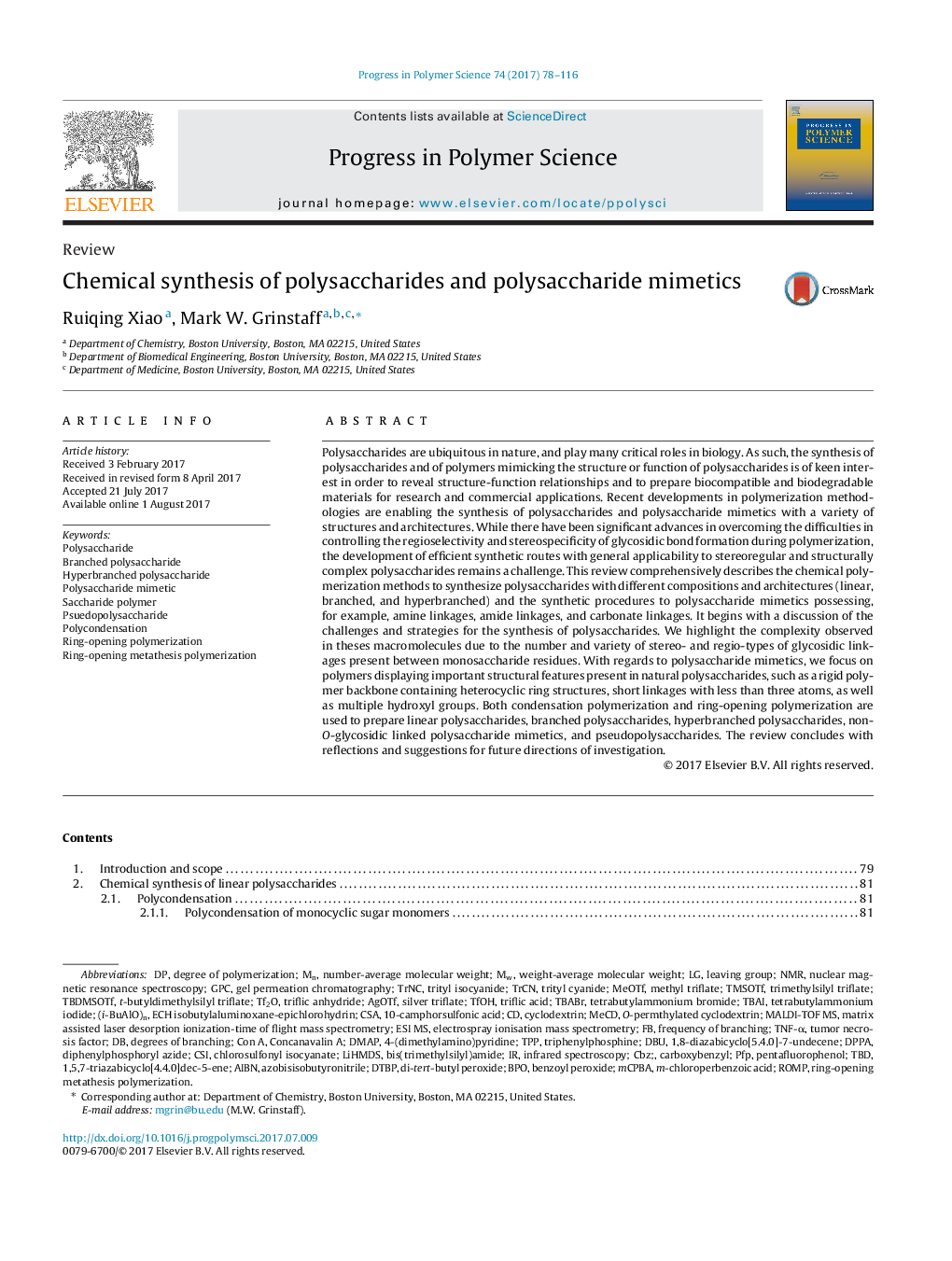| Article ID | Journal | Published Year | Pages | File Type |
|---|---|---|---|---|
| 5207862 | Progress in Polymer Science | 2017 | 39 Pages |
Abstract
Polysaccharides are ubiquitous in nature, and play many critical roles in biology. As such, the synthesis of polysaccharides and of polymers mimicking the structure or function of polysaccharides is of keen interest in order to reveal structure-function relationships and to prepare biocompatible and biodegradable materials for research and commercial applications. Recent developments in polymerization methodologies are enabling the synthesis of polysaccharides and polysaccharide mimetics with a variety of structures and architectures. While there have been significant advances in overcoming the difficulties in controlling the regioselectivity and stereospecificity of glycosidic bond formation during polymerization, the development of efficient synthetic routes with general applicability to stereoregular and structurally complex polysaccharides remains a challenge. This review comprehensively describes the chemical polymerization methods to synthesize polysaccharides with different compositions and architectures (linear, branched, and hyperbranched) and the synthetic procedures to polysaccharide mimetics possessing, for example, amine linkages, amide linkages, and carbonate linkages. It begins with a discussion of the challenges and strategies for the synthesis of polysaccharides. We highlight the complexity observed in theses macromolecules due to the number and variety of stereo- and regio-types of glycosidic linkages present between monosaccharide residues. With regards to polysaccharide mimetics, we focus on polymers displaying important structural features present in natural polysaccharides, such as a rigid polymer backbone containing heterocyclic ring structures, short linkages with less than three atoms, as well as multiple hydroxyl groups. Both condensation polymerization and ring-opening polymerization are used to prepare linear polysaccharides, branched polysaccharides, hyperbranched polysaccharides, non-O-glycosidic linked polysaccharide mimetics, and pseudopolysaccharides. The review concludes with reflections and suggestions for future directions of investigation.
Keywords
BPOGPCTBDESI MSAIBNDPPATBAIAzobisisobutyronitrileROMPm-chloroperbenzoic acidDTBPMethyl triflatemCPBATfOHHyperbranched polysaccharideLiHMDS10-Camphorsulfonic acidBis(trimethylsilyl)amidedi-tert-butyl peroxideConcanavalin ATPPCSIPFPCbzDMAPDBUTMSOTf4-(Dimethylamino)pyridineTriflic anhydrideTriflic acidCSACon Abenzoyl peroxideTetrabutylammonium bromideLeaving grouptrimethylsilyl triflateTriphenylphosphineNMRdegree of polymerizationDiphenylphosphoryl azideCyclodextrinelectrospray ionisation mass spectrometryNuclear magnetic resonance spectroscopyInfrared spectroscopytumor necrosis factorTNF-αMatrix assisted laser desorption ionization-time of flight mass spectrometryMALDI-TOF MSSilver triflateweight-average molecular weightnumber-average molecular weightPolycondensationRing-opening polymerizationRing-opening metathesis polymerizationPentafluorophenolPolysaccharidecarboxybenzylGel permeation chromatographyChlorosulfonyl isocyanateTetrabutylammonium iodide
Related Topics
Physical Sciences and Engineering
Chemistry
Organic Chemistry
Authors
Ruiqing Xiao, Mark W. Grinstaff,
